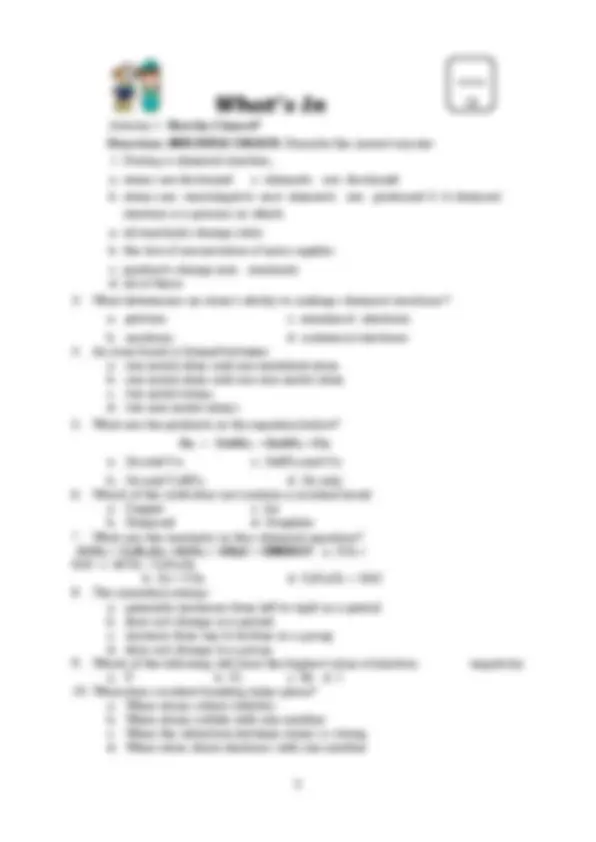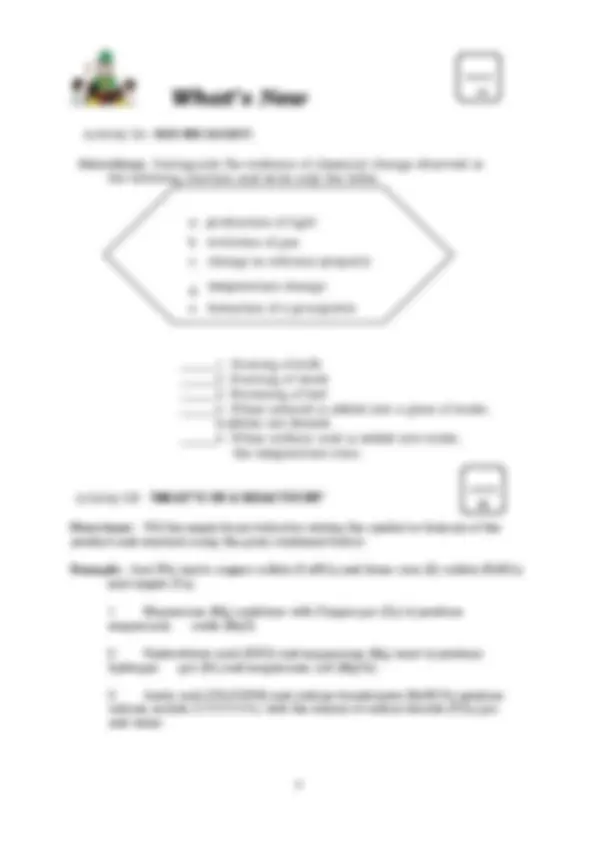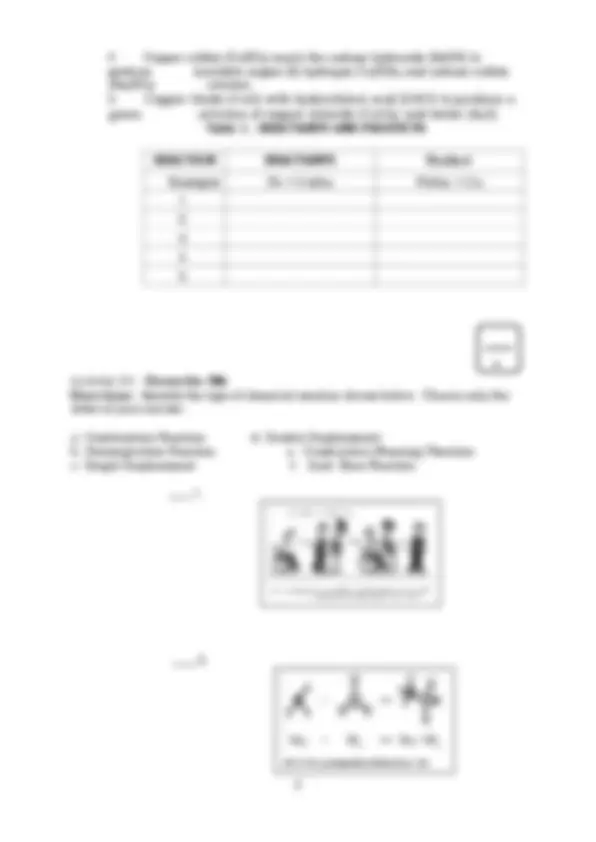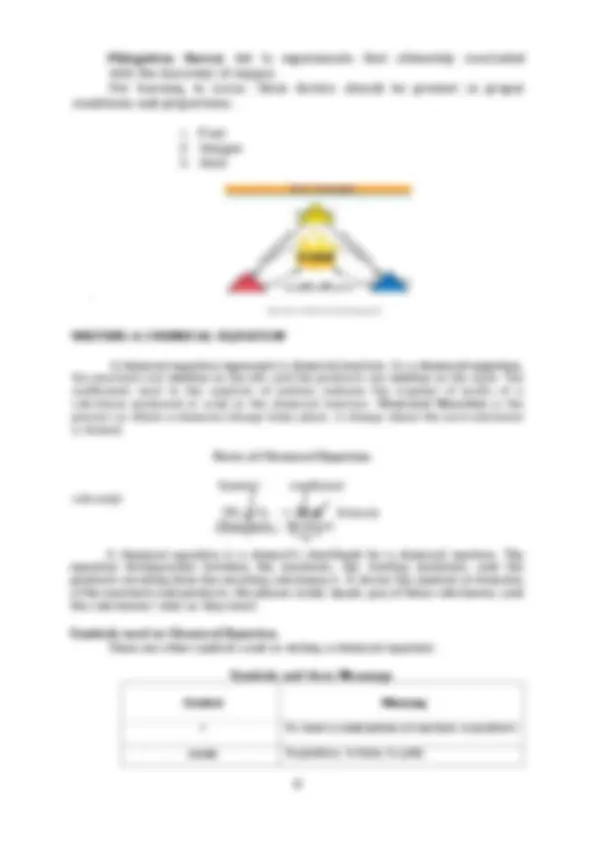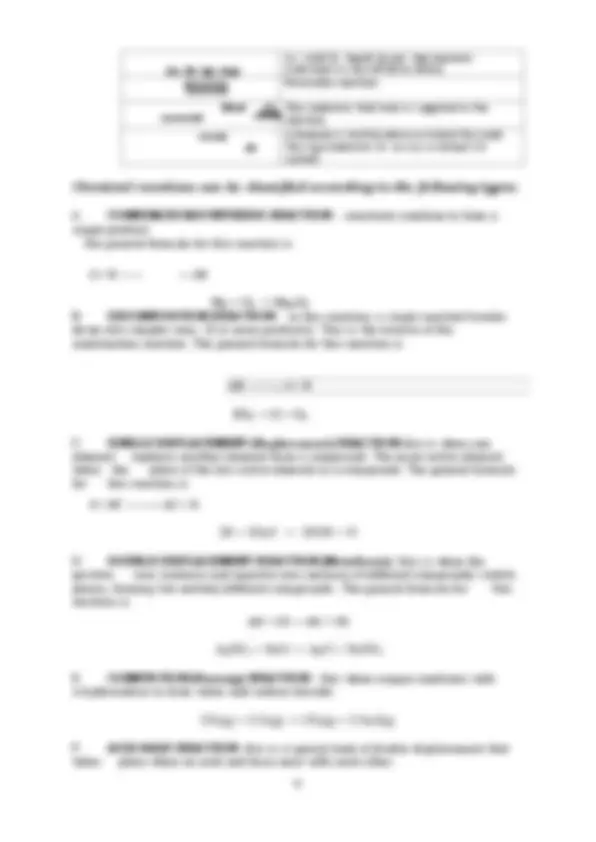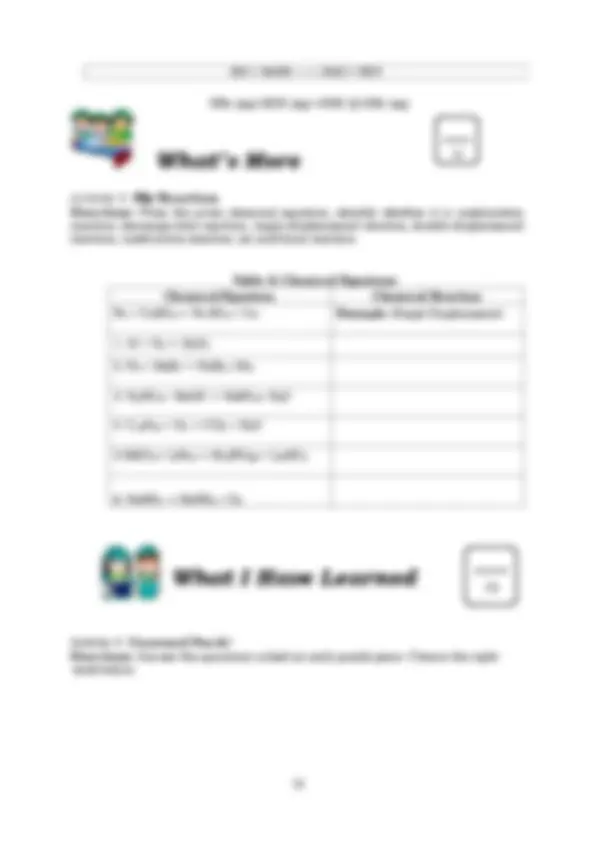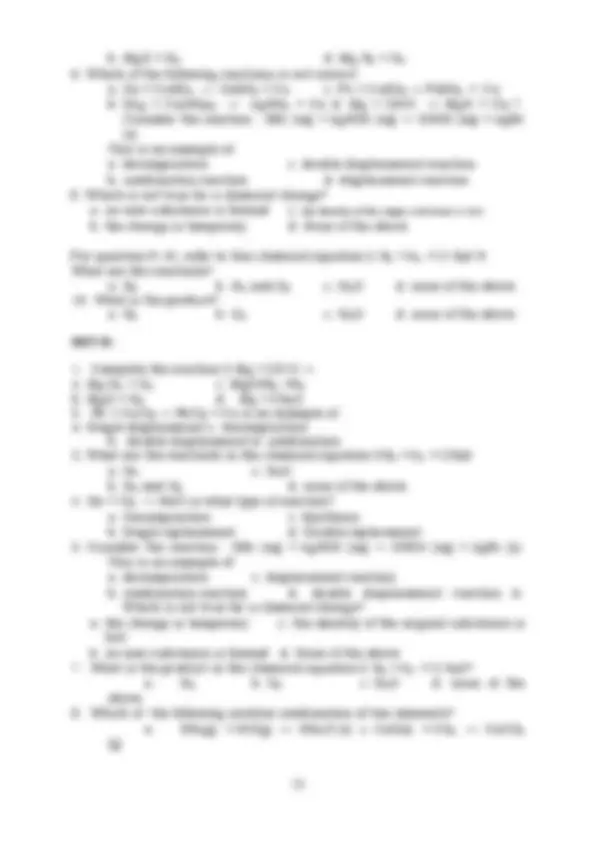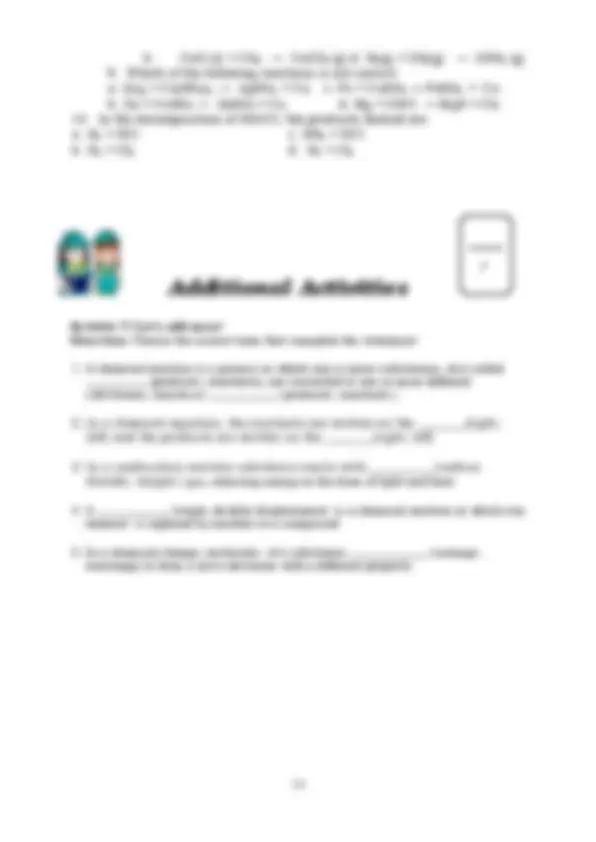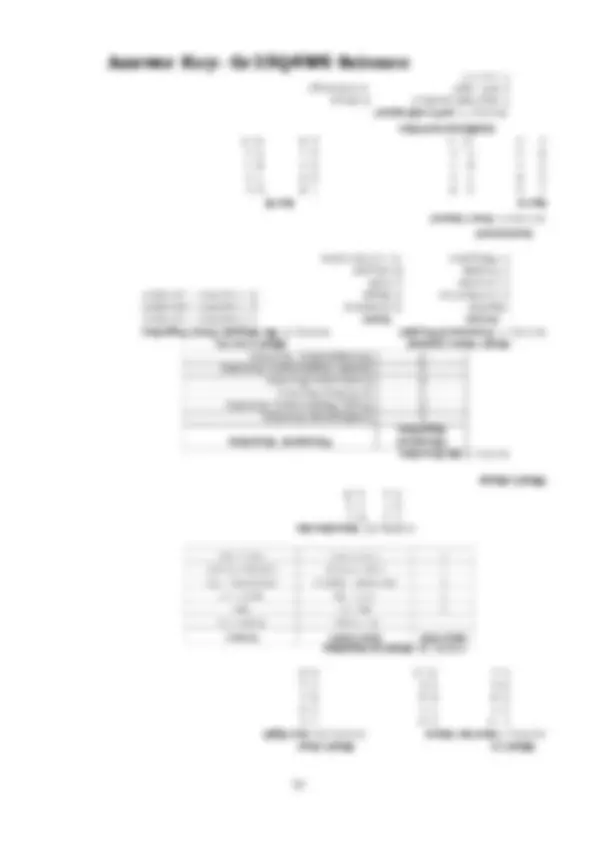Download Chemical Reactions: Understanding Chemical Changes and Conservation of Mass and more Study Guides, Projects, Research Chemistry in PDF only on Docsity!
Republic of the Philippines
Department of Education
Regional Office IX, Zamboanga Peninsula
Science Grade 10
Quarter 4 - Module 5
TYPES OF CHEMICAL REACTION
Name of Learner: _____________________ _________ Grade & Section : ______________________________
Module 5 TYPES OF CHEMICAL REACTION What I Need to Know This module was designed and written to understand the different chemical changes and evidence of chemical changes and to apply the principles of conservation of mass to chemical reactions S10MT-IVe-g- 23 that involved biological and industrial processes affecting life and the environment. To start with, imagine the everyday observations you have like burning a candle, the ripening of fruits, burning fuel, and cooking of food are some of the many examples of chemical reactions in our daily lives. All the changes that take place have a significant effect on our environment and consequently on to our health. After going through this module, you are expected to:
- Identify the evidence of chemical reaction;
- Write the chemical equation and identify the reactant and the product; and
- Differentiate the types of a chemical reactions. You have experienced different chemical reactions without actually realizing it. Yet an understanding of chemical change will help you appreciate more the role of chemistry in our lives.
What’s New Activity 2A: SEE ME RIGHT! Directions : Distinguish the evidence of chemical change observed in the following reaction and write only the letter. a. production of light b. evolution of gas c. change in intrinsic property d. temperature change e. formation of a precipitate ______1. Souring of milk ______2. Burning of wood ______3. Browning of leaf ______4. When antacid is added into a glass of water, bubbles are formed ______5. When sulfuric acid is added into water, the temperature rises.
Activity 2B: WHAT’S IN A REACTION?
Directions: Fill the empty boxes below by writing the symbol or formula of the product and reactant using the given statement below: Example: Iron`(Fe) reacts copper sulfate (CuSO 4 ) and forms iron (II) sulfate (FeSO 4 ) and copper (Cu).
- Magnesium (Mg) combines with Oxygen gas (O 2 ) to produce magnesium oxide (MgO)
- Hydrochloric acid (2HCl) and magnesium (Mg) react to produce hydrogen gas (H 2 ) and magnesium salt (MgCl 2 ).
- Acetic acid (CH 3 COOH) and sodium bicarbonate (NaHCO 3 ) produce sodium acetate (CH3COONa) with the release of carbon dioxide (CO 2 ) gas and water. 10 20
- Copper sulfate (CuSO 4 ) reacts the sodium hydroxide (NaOH) to produce insoluble copper (II) hydrogen Cu(OH) 2 and sodium sulfate (Na 2 SO 4 ) solution.
- Copper Oxide (CuO) with hydrochloric acid (2HCl) to produce a green solution of copper chloride (CuCl 2 ) and water (H 2 O) Table 1: REACTANTS AND PRODUCTS REACTION REACTANTS Product Example Fe + CuSo 4 FeSo 4 + Cu
Activity 2C: Describe Me
Directions: Identify the type of chemical reaction shown below. Choose only the letter of your answer. a. Combination Reaction d. Double Displacement b. Decomposition Reaction e. Combustion (Burning) Reaction c. Single Displacement f. Acid- Base Reaction ____ 1. ____ 2. 2012 Encyclopedia Britannica, Inc. 6
What is it When a physical change occurs, there is no breaking and forming of bonds. Certain things will help us identify if a chemical reaction has taken place. While in chemical change, new substances are formed. For this to occur, the substance breaks chemical bonds, and the atoms compose them separately and rearrange to create a new substance with new chemical bonds. We call these evidence of chemical reactions. A chemical reaction is usually accompanied by physical effects such as the emission of heat, the changes of color, the evolution of gas, a solid formed, and sometimes a pungent smell. It is a change of a substance into a new one that has a different identity. In other words, this evidence of chemical reactions involves the following;
- Production of light
- Evolution of gas
- Temperature change
- Change in intrinsic properties
- Formation of a precipitate Oxygen is vital to life. One exciting reaction which involves oxygen is the production of fire. A fire has fascinated people for so long that the ancient people even regarded it as one of the earliest elements. The fire was so important to them, and they described it as an element that changes everything. The earliest theory about burning was the Phlogiston theory. This theory superseded scientific theory that postulated a fire-like feature called Phlogiston within combustible bodies and released during combustion. This theory superseded scientific theory that postulated a fire-like feature called Phlogiston within combustible bodies and released during combustion. ∞ Johann Joachim Becher (1667 ), who proposed the first idea of Phlogiston ∞ George Ernst Stahl (17th ) attempted to explain chemical processes of weight increase such as combustion and rusting, now collectively known as oxidation. ∞ Antoine Lavoisier, through his careful observations from his experiments debunked the phlogiston theory as he discovered that instead of releasing a substance (phlogiston) a material accurately burns as it reacts (uses) with oxygen. This is now known as the Theory of Oxidation, and this is accepted up to this day.
Phlogiston theory led to experiments that ultimately concluded with the discovery of oxygen. For burning to occur, three factors should be present in proper conditions and proportions.
- Fuel
- Oxygen
- Heat ` http://pslc.ws/fire/howwhy/triangle.htm WRITING A CHEMICAL EQUATION A chemical equation represents a chemical reaction. In a chemical equation , the reactants are written on the left, and the products are written on the right. The coefficients next to the symbols of entities indicate the number of moles of a substance produced or used in the chemical reaction. Chemical Reaction is the process in which a chemical change takes place. A change where the new substance is formed. Parts of Chemical Equation Symbol coefficient subscript 2H 2 + O 2 → 2H 2 O formula Reactants Products A chemical equation is a chemist's shorthand for a chemical reaction. The equation distinguishes between the reactants, the starting materials, and the products resulting from the resulting substance/s. It shows the symbols or formulas of the reactants and products, the phases (solid, liquid, gas) of these substances, and the substances' ratio as they react. Symbols used in Chemical Equation There are other symbols used in writing a chemical equation: Symbols and their Meanings Symbol Meaning + To show a combination of reactants or products. To produce; to form; to yield.
HCl + NaOH ----→ NaCl + H2O HBr (aq)+KOH (aq)→H2O (l)+KBr (aq) What’s More
Activity 3: My Reaction
Directions: From the given chemical equation, identify whether it is combination reaction, decomposition reaction, single displacement reaction, double displacement reaction, combustion reaction, an acid-base reaction. Table 2: Chemical Equations Chemical Equation Chemical Reaction Fe + CuSO 4 → Fe SO 4 + Cu Example: Single Displacement
- Al + O 2 → Al 2 O 3
- Fe + NaBr → FeBr 3 +Na
- H 2 SO 4 + NaOH → NaSO 4 + H 2 O
- C 18 H 18 + O 2 → CO 2 + H 2 O 5.NiSO 4 + LiPo 4 → Ni 3 (PO 4 ) 2 + Li 2 SO 4
- NaNO 3 → NaNO 2 + O 2 What I Have Learned Activity 4: Crossword Puzzle! Directions: Answer the questions asked on each puzzle piece. Choose the right word below. 12 10
combination phlogiston Becher double combustion oxygen Stahl Lavoisier single phlogiston reaction combination ACROSS DOWN 1.proposed the first idea of the Phlogiston Theory
- it is a change where a new substance is formed.
- reaction in which substance reacts with oxygen gas, releasing energy in the form of light and heat
- a kind of displacement in a chemical the reaction in which one element is replaced by another in a compound
- developed experimentally based theory of the chemical reactivity of oxygen
- founder of the phlogiston theory of compulsion
- it is a displacement reaction when the positive and negative ions of different compounds switch places, forming two different compounds.
- vital of life
- a substance exists in all combustible bodies, and to be released in combustion
- reactants combine to form a single product
b. MgO + H 2 d. Mg H 2 + O 2
- Which of the following reactions is not correct: a. Zn + CuSO 4 → ZnSO 4 + Cu c. Fe + CuSO 4 → FeSO 4 + Cu b. 2Ag + Cu(NO 3 ) 2 → AgNO 3 + Cu d. Mg + 2HCl → MgH + Cl 2 7. Consider the reaction : KBr (aq) + AgNO3 (aq) → KNO3 (aq) + AgBr (s). This is an example of: a. decomposition c. double displacement reaction b. combination reaction d. displacement reaction
- Which is not true for a chemical change? a. no new substance is formed c. the identity of the origin substance is lost b. the change is temporary d. None of the above For question 9-10, refer to this chemical equation 2 H 2 + 0 2 → 2 H 2 0 9. What are the reactants? a. H 2 b. H 2 and O 2 c. H 2 O
- What is the product? d. none of the above a. H 2 b. O 2 c. H 2 O SET B:
- Complete the reaction 2 Mg + 2H O → a. Mg H 2 + O 2 c. Mg(OH) 2 +H 2 b. MgO + H 2 d. Mg + 2H 2 O
- Pb + CuCl 2 → PbCl 2 + Cu is an example of a. Single displacement c. decomposition b.. double displacement d. combination d. none of the above
- What are the reactants in the chemical equation 2H 2 + 0 2 → 2H 20 a. H 2 c. H 2 O b. H 2 and O 2 d. none of the above
- Na + Cl 2 --> NaCl is what type of reaction? a. Decomposition c. Synthesis b. Single replacement d. Double replacement
- Consider the reaction : KBr (aq) + AgNO3 (aq) → KNO3 (aq) + AgBr (s). This is an example of: a. decomposition c. displacement reaction b. combination reaction d. double displacement reaction 6. Which is not true for a chemical change? a. the change is temporary c. the identity of the original substance is lost b. no new substance is formed d. None of the above
- What is the product in the chemical equation 2 H 2 + 0 2 → 2 H 2 0? a. H 2 b. O 2 c. H 2 O d. none of the above
- Which of the following involves combination of two elements? a. NH 3 (g) + HCl(g) → NH 4 Cl (s) c. CaO(s) + CO 2 → CaCO 3 (g)
b. CaO (s) + CO 2 → CaCO 3 (g) d. N 2 (g) + 3H 2 (g) → 2NH 2 (g)
- Which of the following reactions is not correct: a. 2Ag + Cu(NO 3 ) 2 → AgNO 3 + Cu c. Fe + CuSO 4 → FeSO 4 + Cu b. Zn + CuSO 4 → ZnSO 4 + Cu d. Mg + 2HCl → MgH + Cl 2
- In the decomposition of NH4Cl, the products formed are a. N 2 + HCl c. NH 3 + HCl b. H 2 + Cl 2 d. N 2 + Cl 2 Additional Activities Activity 7: Let’s add more! Direction: Choose the correct term that complete the statement.
- A chemical reaction is a process in which one or more substances, also called ___________ (products, reactants), are converted to one or more different substances, known as ____________ ( products, reactants )
- In a chemical equation, the reactants are written on the ________(right, left) and the products are written on the ________(right, left)
- In a combustion reaction substance reacts with ___________(carbon dioxide, oxygen ) gas, releasing energy in the form of light and heat.
- A _____________ (single, double) displacement is a chemical reaction in which one element is replaced by another in a compound.
- In a chemical change, molecules of a substance ______________ ( arrange, rearrange) to form a new substance with a different property.

